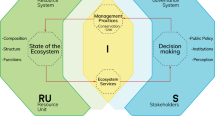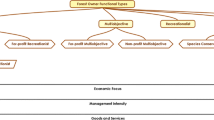Abstract
Although much has been written on the human dimensions of forest management, there has been little empirical investigation of how forest stakeholders themselves conceptualize this domain. We used a conceptual content cognitive mapping (3CM) task along with a short survey to explore the perspectives of 23 forest stakeholders in the Pacific Northwest on the human factors relevant to appropriate forest management. Study participants were chosen from three groups: employees of the U.S. Forest Service at the Mount Baker-Snoqualmie Forest, employees of a large timber company, and area environmentalists. Three distinct human dimensions emerged: Traditional intangible benefits (aesthetic concerns, recreation and cultural resources), Values and expectations (considering multiple values, maintaining public expectations, considering social acceptability and maintaining public confidence in forestry), and Process issues indecision making (public involvement, communication across boundaries, collaboration and taking an interdisciplinary approach). In this article, we discuss these three dimensions, the differences found among the stakeholder groups in the importance they placed on each of these dimensions, and the benefits of the 3CM method in this context.
Similar content being viewed by others
References
Austin, D. E. (1994) Incorporating cognitive theory into environmental policymaking. Environmental Professional 16, 262-74.
Borgatti (1992) Anthropac 4.0.Analytic Technologies, Columbia.
Brown, B. A. (1995) In Timber Country.Temple Univ. Press, Philadelphia, PA.
Brunson, M.W., Kruger, L. E., Tyler, C. B. and Schroeder, S. A., eds (1996) Defining Social Acceptability in Ecosystem Management: A Workshop Proceedings.Tech. Rep. PNW-GTR-369. U.S. Department of Agriculture, Forest Service, Pacific Northwest Research Station, Portland, OR.
Clinton, W. J. (1993) Remarks at the conclusion of the forest conference in Portland, OR, April 2, dy1993. Weekly Compilation of Presidential Documents 29(14), 529-31.
FEMAT (1993) Forest Ecosystem Management: An Ecological, Economic, and Social Assessment.Report of the Forest Ecosystem Management Assessment Team.
Fisher, R. and Ury, W. (1991) Getting to Yes: Negotiating Agreement Without Giving In.Penguin Books, New York, NY.
Goode, W. J. and Hatt, P. K. (1952) Methods in Social Research.McGraw-Hill, New York, NY.
Grumbine, R. E. (1994) What is ecosystem management? Conservation Biology 8(1), 27-38.
Johnson, S. (1967) Hierarchical clustering schemes. Psychometrika 38, 241-54.
Jones, G. T. (1995) The careful timber harvest: a guide to logging esthetics. J. Forestry 93(2), 12-5.
Kearney, A. R. and Bradley, G. (1996) Defining the dialogue around ecosystem management: an analysis of the recent literature. Report prepared for the USDA Forest Service Pacific Northwest Research Station, Seattle, WA.
Kearney, A. R., Bradley, G., Kaplan, R., and Kaplan, S. (In Press) Stakeholder perspectives on appropriate forest management in the Pacific Northwest. Forest Science.
Kearney, A. R. and Kaplan, S. (1997) Toward a methodology for the measurement of knowledge structures of ordinary people: the conceptual content cognitive map (3CM). Environment and Behavior 29(5), 579-617.
Kerr, A. (1995) Ecosystem management must include the most human of factors. Bioscience 45(6), 378.
Machlis, G. E., Force, J. E. and Burch, W. R. (1997) The human ecosystem Part 1: The human ecosystem as an organizing concept in ecosystem management. Society Natural Resources 10, 347-67.
Moote, M. A., Burke, S., Cortner, H. J. and Wallace, M. G. (1994) Principles of Ecosystem Management. Water Resources Research Center, College of Agriculture, University of Arizona.
Multiple-Use Sustained-Yield Act of 1960. 16 U.S.C.A. §528 et seq.
National Environmental Policy Act of 1969. 42 U.S.C.A. §4331 et seq.
National Forest Management Act of 1976. 16 U.S.C.A. §1600 et seq.
Neale, M. A. and Bazerman, M. H. (1983) The role of perspective-taking ability in negotiating under different forms of arbitration. Industrial Labor Relations Rev. 36(3), 378-88.
Regional Ecosystem Office, (1995) Ecosystem Analysis at theWatershed Scale: Federal Guide forWatershed Analysis, Version 2.2.Regional Ecosystem Office, Portland, OR.
Robson, C. (1993) Real World Research: A Resource for Social Scientists and Practitioners-Researchers. Blackwell Publishers, Oxford.
Sauley, K. S. and Bedeian, A. G. (1989). 05: a case of the tail wagging the distribution. J. Management 15(2), 335-44.
Schuh, D. (1995) Managing esthetic values: Weyerhaeuser Company's approach. J. Forestry 93(2), 20-5.
Stankey, G. H. and Clark, R. N. (1992) Social Aspects of New Perspectives in Forestry: A Problem Analysis. Grey Towers Press, Milford, PA.
Systat for Windows, 1992. Version 5 Edition. Systat, Inc., Evanston, IL.
USDA Forest Service National Human Dimensions of Ecosystem Management Task Team, (1994) Human dimensions in ecosystem management: a concept paper.
Yaffee, S. L. (1994) TheWisdom of the Spotted Owl: Policy Lessons for a New Century.Island Press, Washington, DC.
Author information
Authors and Affiliations
Rights and permissions
About this article
Cite this article
Kearney, A.R., Bradley, G. Human dimensions of forest management: an empirical study of stakeholder perspectives. Urban Ecosystems 2, 5–16 (1998). https://doi.org/10.1023/A:1009564812609
Issue Date:
DOI: https://doi.org/10.1023/A:1009564812609




